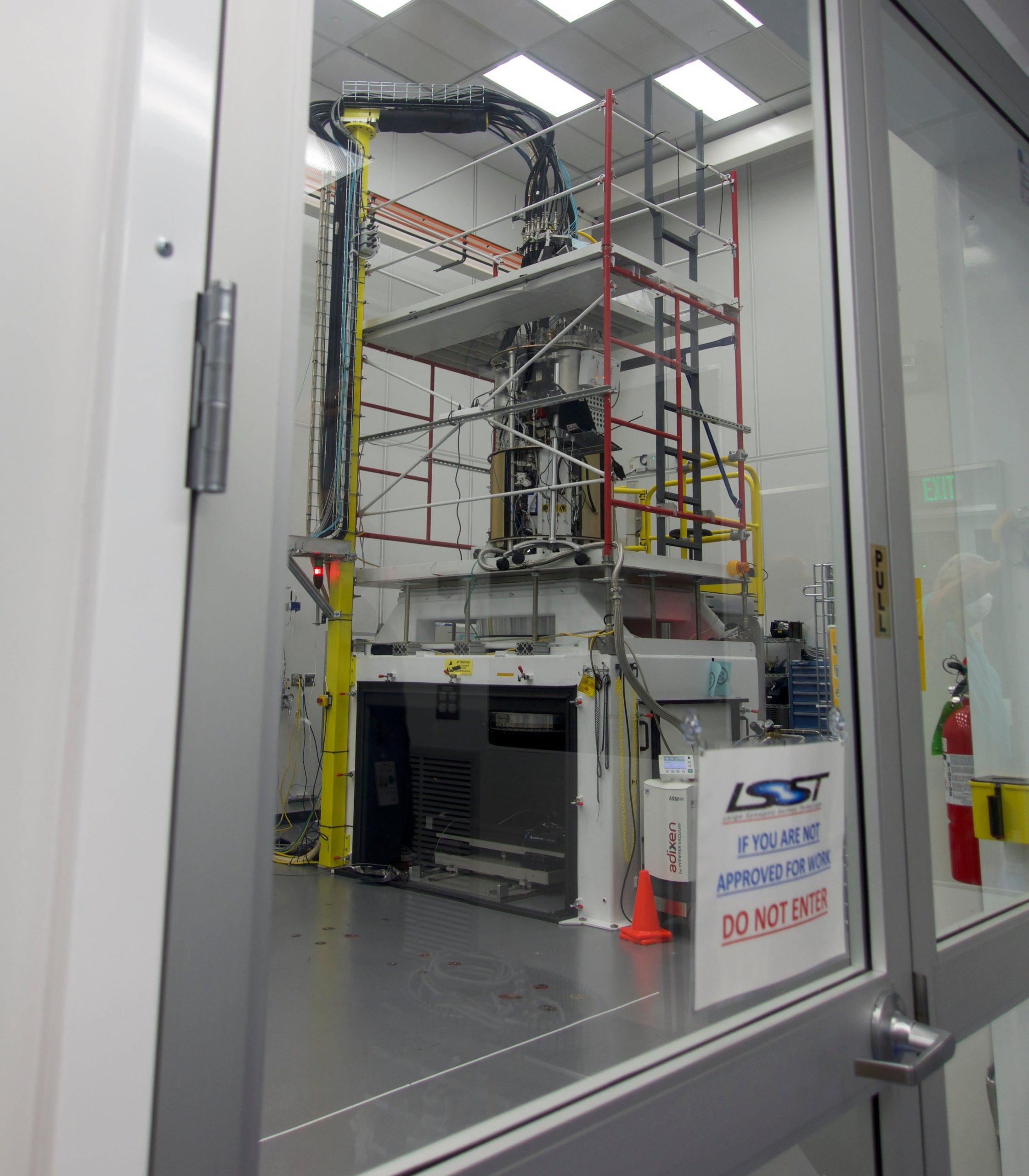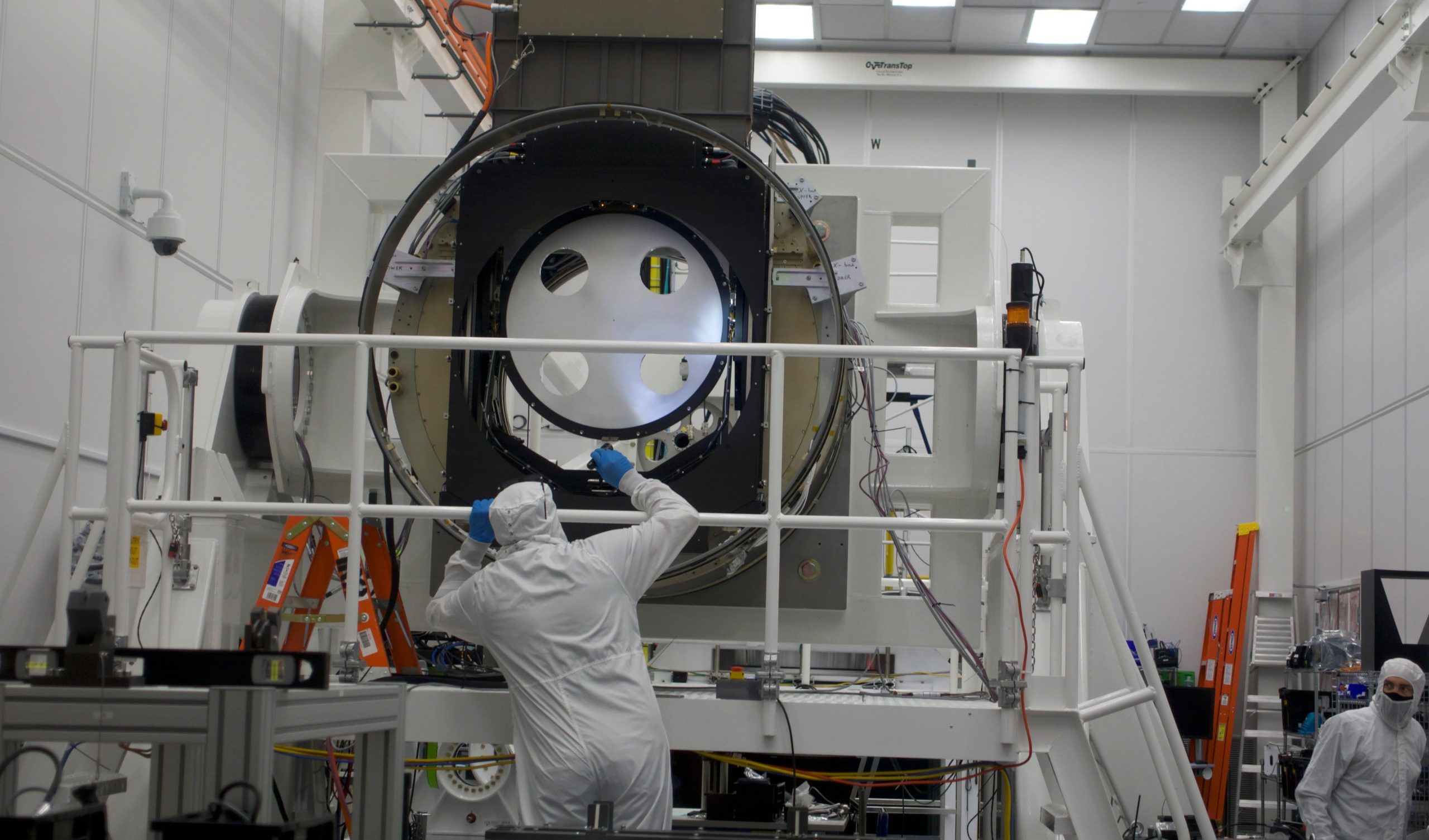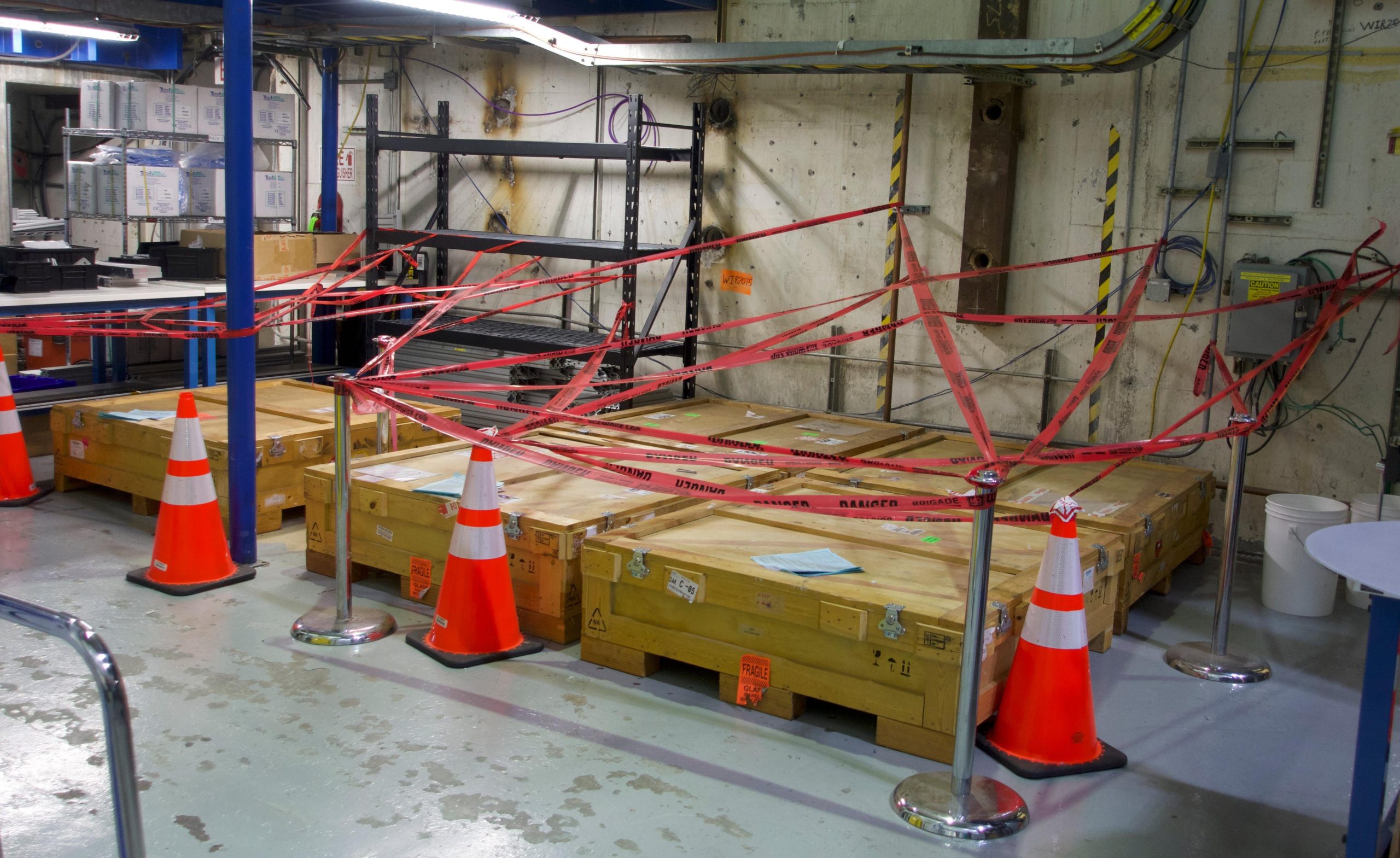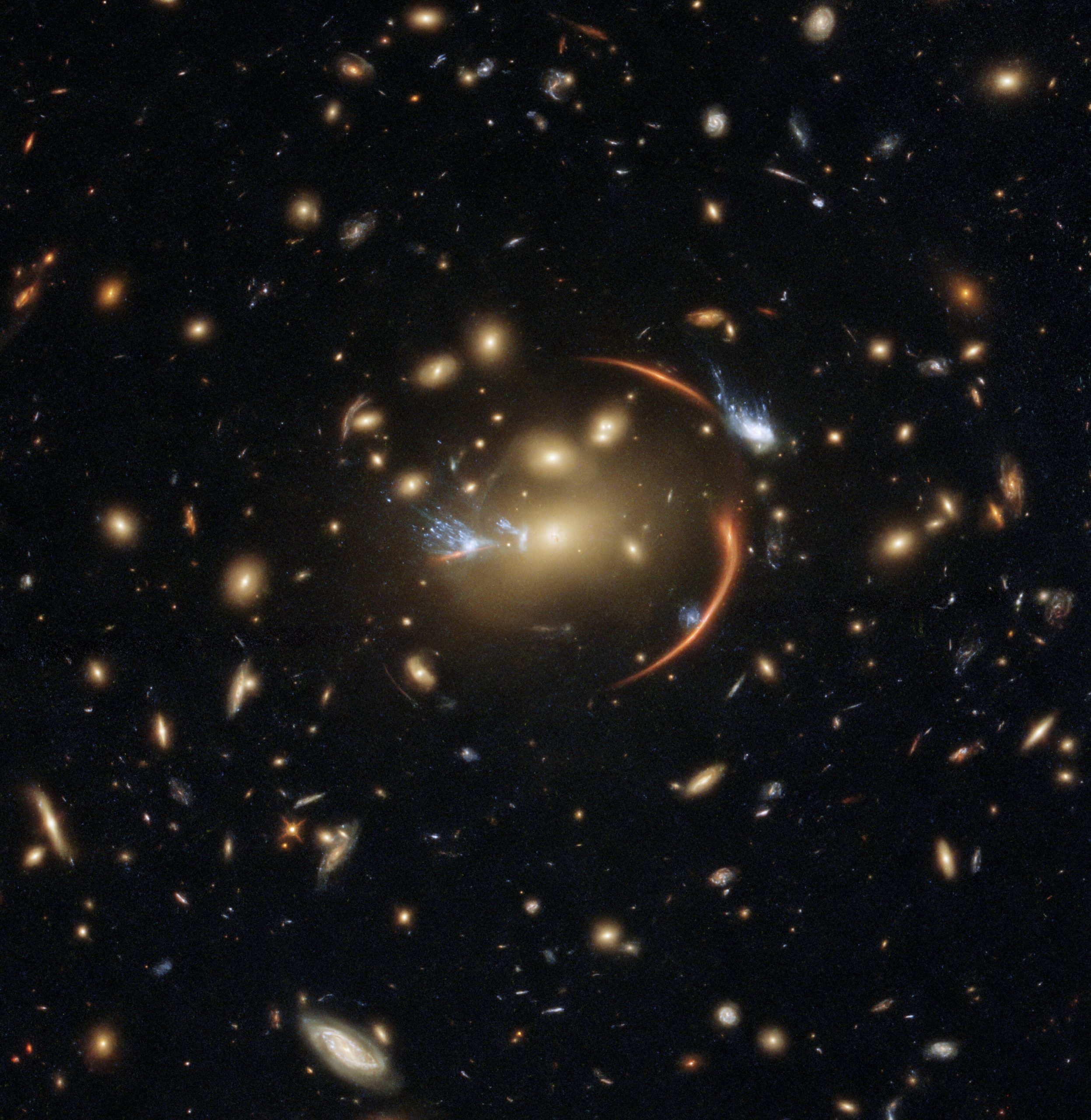In an old experimental hall previously used for particle physics experiments, a team of French engineers are checking the filters on what will be the largest digital camera ever built. It’s October 2021, and I’m seeing the camera during its assembly at SLAC National Accelerator Laboratory in Menlo Park, California. When this high-resolution imager is finally put to work, it will give us breathtaking views of the deep universe.
The instrument is the Legacy Survey of Space and Time (LSST) Camera. The 3.2-gigapixel (3.2 billion pixel) camera will eventually be installed at the Vera Rubin Observatory on a Chilean mountaintop, where it will image half of the southern sky every three days. It will give astronomers, astrophysicists, and cosmologists a complete portrait of that region of the sky about once a week.
“We will see dimmer objects than people have looked at before in an area on the sky,” astrophysicist Aaron Roodman, lead scientist for camera assembly and testing, told Gizmodo. “People have done things deep, but they’ve been in tiny regions of the sky.” The new telescope will be able to look far, far into the distance — and therefore the past — over a huge region.

The weekly portraits together will form the Legacy Survey of Space and Time, a 10-year survey of the southern sky that will collect data on the shapes, locations, and colours of objects in space, including millions of stars and billions of galaxies. The images — taken every 15 seconds — will allow researchers to keep a watchful eye on near-Earth asteroids, gain insights about the origin and evolution of the Milky Way, learn about the nature of dark matter and dark energy, and potentially discover entirely new phenomena in the cosmos.
“The main deal is just get as much of the sky as quickly as possible and just do that repeatedly,” Steven Kahn, an astrophysicist and the director of the Rubin Observatory, told Gizmodo. “The simplest thing it can do is just say, ‘What’s changed? How has it changed?’ And we will do that up the wazoo.”
The regularity of the camera’s images will effectively provide a real-time understanding of events in space both near and distant, providing a comprehensive look at just how dynamic our universe is.

The LSST camera has six optical filters that rotate like a lazy Susan, to be swapped in and out depending on the light conditions on a given night and what objects the staff is trying to capture. The filters will allow the camera to image the sky in six different bands of the electromagnetic spectrum, from the near-ultraviolet to the near-infrared.
Originally, the plan was to install the camera in Chile by 2014, but the camera’s production has been hampered by delays, most recently due to covid-19. Even without the challenges of a pandemic, managing such a large interdisciplinary team of scientists and engineers “is like herding cats,” Roodman said. But now things are finally coming together.
“If it hadn’t been for covid, we would have shipped the camera like a year ago,” Khan said, “and at this stage, since everything’s pretty close to assembled, everything’s critical.”
The camera’s front end consists of three lenses and whichever filter is in use. Fairly straightforward. But behind that is the crown jewel of the 1.68 m-wide, 3.05 m-long camera: its focal plane, the area on which light from the telescope’s mirrors is cast.
The focal plane is made up of 189 charge-coupled devices (CCDs), which are arranged in 21 groups of nine, all cooled in a vacuum to nearly -150° Fahrenheit, to reduce noise in the images and thereby increase the camera’s sensitivity. Each 0.61 m-long CCD is topped with the square sensors that make up the focal plane, which is so flat it doesn’t tilt more than 10 microns in any direction. (A human hair is about 70 microns across.) CCDs are basically digital cameras in themselves; grouped together in rafts of nine, they capture mosaic images of the sky. It’s this piece of technology that will ingest all the light reflected off the telescope’s three mirrors.
Putting together the focal plane was a beast; the raft of CCDs needed to be packed into an array very flatly and very close together, but they couldn’t actually touch, to avoid damaging any one of them. “If you have gaps, we’re just wasting the light. Stars are going to fall in that space and then we won’t get the data,” Kahn said, adding that putting the plane together was like parking a luxury car with less than a centimeter of clearance. Each raft is more expensive than a Maserati, Roodman said, making the assembly (which took place in this clean room at SLAC) a pretty stressful process. The team tested the completed focal plane out on a head of broccoli last year.
Once it’s in Chile, the camera will sit between three mirrors; one above, two below. The primary mirror is 27.56 feet (8.4 meters) across, and the tertiary mirror is 16.4 feet (5 meters) across. The secondary mirror between them is 11.2 feet (3.42 meters) across and is the largest convex mirror ever made, according to the Rubin Observatory team.
The focal plane will actually point toward the ground to capture images of space. Light from the night sky will bounce off one of the lower mirrors, up to the higher, convex mirror, and then back down to the final mirror before finally reflecting into the camera.
I learned about all this in a gowning room at SLAC National Accelerator Laboratory, where engineers working in a custom-built clean room put on special booties and bunny suits to avoid bringing any outside dust or detritus into the camera’s vicinity. This building was once used for antimatter research. When the Rubin Observatory team moved in, they had to deal with a “boneyard” of old instruments, Roodman said. The clean room was built within the hanger-like experimental hall and is tall enough to fit a crane that will insert the cryostat — the capsule that contains all supercooled elements and maintains those temperatures — and the trunk of electronic components into the camera, most likely in February 2022.

Someday, the camera will be swivelling to and fro, generating huge amounts of data every night. But first it has to make it safe and sound to the Rubin Observatory. The plan is to send the camera down to Chile in late summer 2022. The team is, understandably, stressed about the trip. This past summer, they sent a rough substitute for the camera, called a mass surrogate, to Chile, to test the sort of shocks the delicate camera would have to deal with in transit. The surrogate looks a lot like a shipping container but has the same mass and centre of gravity as the LSST camera. It was outfitted with sensors to measure how much shock it underwent during the journey.
“Because of covid, chartering a flight to fly that was going to be ridiculously expensive for a mass surrogate,” Kahn said. “So we went on a more commercial thing, but they wouldn’t leave out of San Francisco, they’d only leave out of Miami, so we trucked it across the country to Miami. And then we were flying it from Miami to Santiago, but for God knows what reason they stopped in Brazil… It wasn’t exactly representative.”
“Well, it was worse,” Roodman added. “So it’s a good test.”

Each night, the camera will put out 15 terabytes of data on the brightness, locations, shapes, and colours of objects it see. The Rubin Observatory will send out 10 million automated alerts per night about the information therein. In the past, astronomers, astrophysicists, and cosmologists could rely on emailed updates and other notices about new, interesting phenomena in space. “The real challenge is actually filtering through these 10 million things per night,” Kahn said. “How do you find the really unusual things that separate the wheat from the chaff?” To a certain extent, Kahn said, the filtering process will be automated. But superlative events will be able to be picked out and disseminated immediately, so other observatories around the world will be able to swivel to an intriguing event at a moment’s notice. The more data from more instruments, the better.
Besides the camera’s tremendous resolution, its field of view (large enough to encompass 40 full moons of astral real estate) will overhaul scientists’ ability to pick out patterns in the universe. With such frequency of images across such a span of sky, the team can effectively track how tons of objects are changing over time. It amounts to a stop-motion movie of the observable universe (in the southern hemisphere).

Some events will be particularly exciting to see with a super-sharp camera, like lensing events, which happen when light is bent by the gravitational fields of massive objects. In strong lensing events, light bends so drastically around an object on its way to Earth that it arrives here at different times, resulting in double or triple views of the same source. That’s the situation for the Requiem supernova, which flashed thrice from our perspective in 2016.
Dark matter, the mysterious stuff that seems to make up most of the universe but can’t actually be seen, is a natural target for the observatory.
“In the course of my career, bright people realised, ‘Oh my god, the universe has lots of dark matter,’ ‘Oh, there’s even more dark matter than regular matter,’ and then actually, three-quarters of the stuff in the universe isn’t even matter. It’s this other thing. So, you know, studying that is irresistible,” Roodman said.
Scientists also still aren’t sure what drives the universe’s accelerating expansion, or why the Hubble parameter is calculated as a different number depending on whether you measure it using close objects or the cosmic microwave background.
“We have these big mysteries. But at the same time, we have a Standard Model of particle physics and actually a standard model of cosmology, which are remarkably successful, extremely well tested, and quantitatively remarkably successful. But they don’t really make any sense,” Kahn said. “And yet something’s got to be right, because there’s no way in hell these mathematical predictions would be so precisely realised.”
The camera, sadly, will have to deal with human-made pollution: namely, the constellations of satellites, like SpaceX’s Starlink, that could show up in as many as 30% of the images the LSST camera takes. Passing satellites can obscure data or even become their own, misleading data points. The new camera “requires access to the pristine unpolluted night sky that for millennia has been the birthright of Earth’s inhabitants,” wrote the science team that measured the potential astronomical disruption.
Even with these challenges, the LSST is likely to drive some of the most exciting astrophysical discoveries of the coming decades. All the images it collects will be available to the public, meaning that, even if you’re not an astrophysicist, you’ll be able to ogle the fascinating behaviours of cosmic objects to your heart’s content. The observatory’s first light is currently slated for January 2023, with operations to be in full swing by that October. There are huge outstanding questions about how the universe took shape and continues to change, and this camera will help us find their answers.
